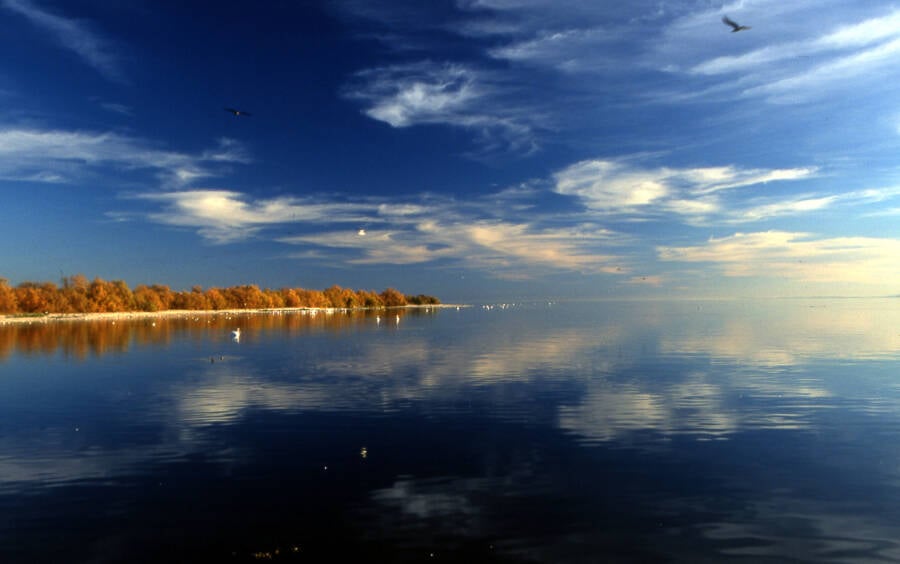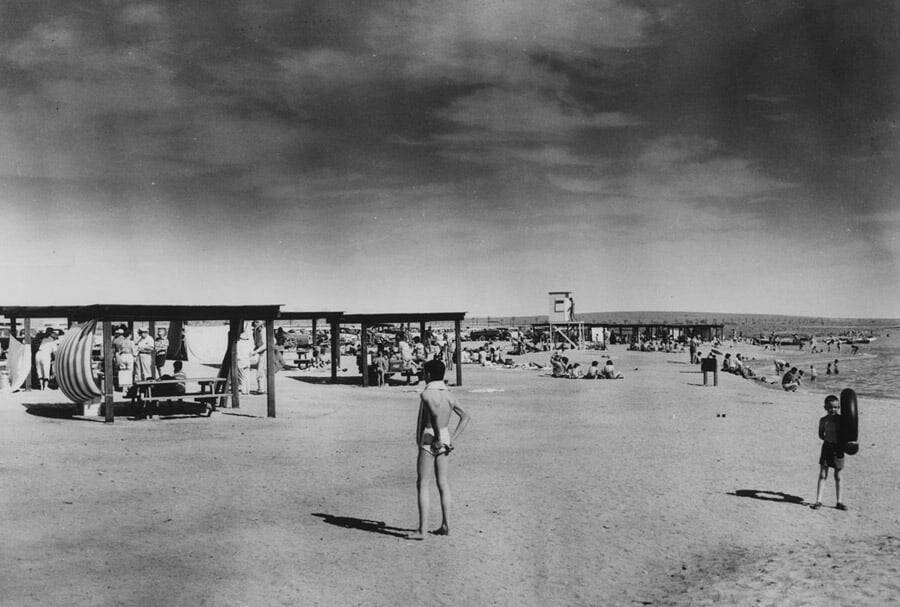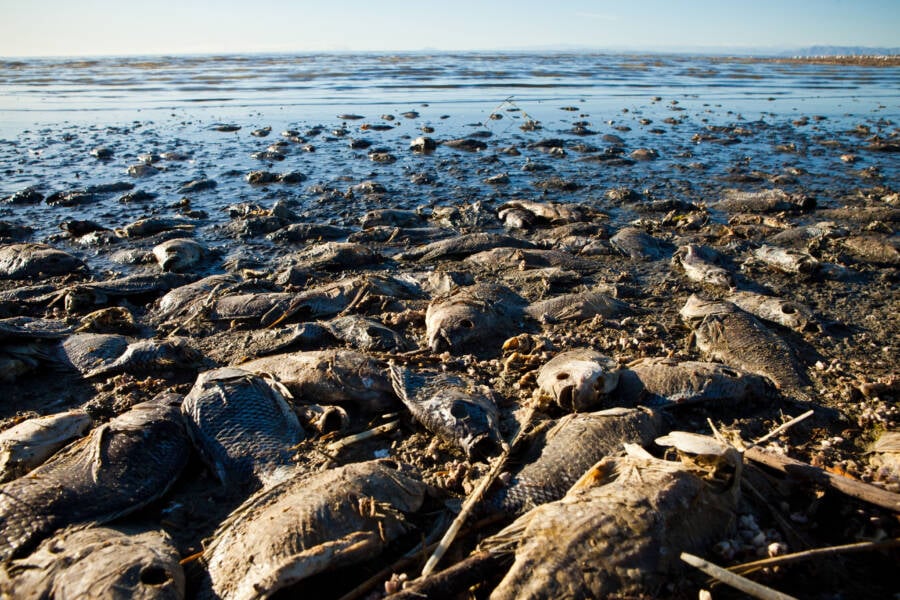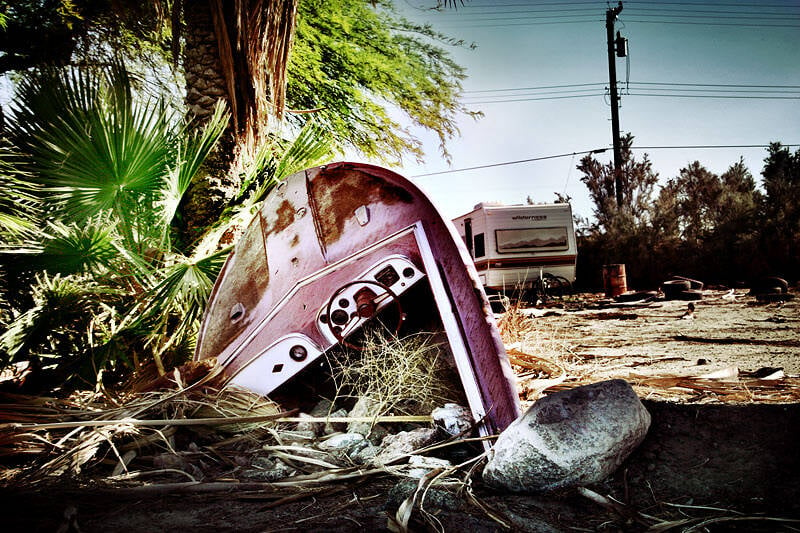A man-made, highly saline lake in Southern California, the Salton Sea is the site of one of America's worst environmental catastrophes.

Wikimedia CommonsA man-made body of water, Salton Sea is highly salty and slowly shrinking.
Decades ago, Salton Sea was one of California’s most beloved tourist destinations. A man-made, saline lake, located near Anza-Borrego Desert State Park and Joshua Tree National Park, Salton Sea was widely seen as the ultimate desert oasis. But now, the body of water is drying up, emitting toxic dust, and releasing noxious air — and the surrounding community in the region has been largely abandoned and forgotten.
Looking at Salton Sea today, it’s hard to believe that it once rivaled the nearby city of Palm Springs and brought in more tourists than the famed Yosemite National Park. Playing host to the North Shore Beach and Yacht Club, the largest marina in Southern California, it attracted the likes of Frank Sinatra, Bing Crosby, Desi Arnaz, and the Beach Boys.
So, how could one of California’s most popular resort communities become a shrinking, dried-up wasteland?
The answer is multifaceted, but the downfall of the man-made lake can mostly be attributed to its poor construction and its lack of an outlet to the ocean. Still, in its century-long history, the Salton Sea has established quite a legacy for itself.
How The Salton Sea Was Created

Wikimedia CommonsAn early 20th-century photo of the Colorado River.
The Salton Sea was created in 1905 when water from the Colorado River spilled out of a poorly-constructed California Development Company irrigation system and into a basin in the desert. The lake then expanded in size for several years until workers were able to put a stop to the flow.
By this time, a 400-square-mile body of water had formed on the basin in Southern California. This lake would later become known as the Salton Sea.
According to the California Department of Fish and Wildlife, the Salton Sea has been maintained by irrigation runoff coming from the Imperial and Coachella valleys and nearby rivers ever since its formation.
Notably, the body of water is an endorheic lake, meaning that its waters have no outlet to the ocean and so they either seep into the ground or evaporate. This situation has led to the man-made lake having an extremely high salinity level — which is currently more than 50 percent saltier than the waters of the Pacific Ocean — that continues to rise as time goes on.
Unfortunately, this ever-increasing salinity has proved disastrous for local wildlife. This, in combination with other issues such as rising temperatures, low levels of oxygen in the water, and increased algae production, has been a primary factor in the decline of what was once a thriving location.
Of course, it wasn’t always like this. In its early history, the Salton Sea was regarded as a beautiful oasis of sorts, and the California government funneled plenty of time and resources into maintaining this image.
The Heyday Of Salton Sea

Los Angeles Public LibraryA group of boaters gathered along the shore of the Salton Sea.
The high salinity levels of the Salton Sea were actually quite beneficial at one point, serving as a major draw for eager tourists and boat owners.
Per The San Diego Union-Tribune, more than 2,000 people showed up at Salton Sea in 1929 to observe boaters set five world speedboat records.
Interestingly enough, because Salton Sea is more than 200 feet below sea level and has higher salinity than many other bodies of water like it, the barometric pressure and saltiness of the water actually made the speedboats more buoyant and led their captains to perform better.
A little over two decades later, an additional 21 world records were set during a 1951 regatta, delighting the large crowds of onlookers.

Los Angeles Public LibraryFamilies at Salton Sea during its heyday.
In the 1950s, the California Department of Fish and Game made efforts to draw anglers to the man-made lake by stocking it with a variety of fish, including sargo, corvina, croaker, among other species. Around the same time, water skiing became a central attraction at Salton Sea as well.
By the end of the decade, a property developer by the name of Penn Phillips had taken a deep interest in developing the area around Salton Sea. He bought and sold thousands of acres of land along the lake’s western shores with the goal of growing the future Salton City into a thriving community.
Then, without any explanation, Phillips suddenly abandoned his plans in 1960. Salton City never grew into anything more than a small number of homes, sewers, and a rough grid of empty streets with names that highlight how promising this venture may have once seemed to prospective community members — names like Sea View Avenue and Sea Mist Place.
It seemed as if Penn Phillips somehow knew that the dream of Salton Sea was about to become a nightmare. Shortly after his abandonment of the development of Salton City, the surrounding area slipped into a gradual downward trajectory, and Salton Sea has never truly recovered from it.
The Decline Of A Destination

Wikimedia CommonsThe current state of Salton City, littered with the remains of what should have been beautiful homes.
By the 1970s, rising salinity, shoreline flooding, and fertilizer runoff from nearby farmers led to an increase in environmental issues in the area surrounding Salton Sea and, thus, a decrease in tourism.
Between 1976 and 1977, a number of tropical storms also ravaged the region, destroying some of the best resorts and marinas. This only led to further economic decline in the region as the environmental problems worsened.
Before long, many species of fish in the lake started to die off due to the increasing salinity and chemical shifts in the water. Eventually, fish bones began to pile up on the beaches that had once hosted tourists. Today, only a handful of fish species live in and around the lake, like tilapia and the endangered desert pupfish, and their numbers are dwindling as well.
Perhaps unsurprisingly, the decline of fish in the saline lake has led to a decline of fish-eating birds in the area. Many of these birds have succumbed from avian botulism after feasting on infected, dying fish in the water.
According to a CNBC report from 2021, these ongoing environmental issues have turned what was once a thriving resort area into something akin to a post-apocalyptic hellscape, with Frank Ruiz, Audubon’s Salton Sea Program Director, referring to the lake’s current problems as “the worst environmental, health, and economic crisis in modern history.”

Planetpix/Alamy Stock PhotoPiles of dead fish along the shore of Salton Sea.
And despite attempts to revitalize Salton Sea, things have seemingly only gotten worse. Part of the problem came from California’s attempt to funnel less water away from the Colorado River, which also supplies water and power to more than 40 million people across California, Arizona, and other states. This led to a significant decrease in Salton Sea’s water levels.
Nearby Imperial County, however, seems to be bearing the brunt of Salton Sea’s increasing environmental decline. Notably, the residents of one of California’s poorest counties have frequently been affected by a “rotten-egg odor” coming from Salton Sea. This terrible smell is a result of high levels of hydrogen sulfide overpowering the lake’s low levels of oxygen.
To make matters worse, Imperial County also faces clouds of dust billowing away from the dried-up lakebed — dust which contains toxins such as arsenic and selenium. The effects have been disastrous for locals.
Imperial County now has some of the worst air quality in the United States, and it nearly doubles the California state average for the number of children going to the emergency room for asthma-related health issues.

Wikimedia CommonsAn abandoned boat lying in the dried lakebed of Salton Sea.
“If the sea was next to Los Angeles, it would have been fixed long ago,” Ruiz said. “But it’s next to poor communities — and they don’t have the political leverage.” He added, “I think things will change when the sea starts affecting wealthier communities in Palm Springs. When the gated communities start feeling the effects of poor air quality, more action will be taken.”
In 2018, California instituted the Salton Sea Management Program to try and help address some of the most persistent issues in the area. California’s Natural Resources Agency also announced a 10-year plan stating that it intends to establish 30,000 acres of habitat and dust suppression projects at the lake alongside plans to import new water into the lakebed.
However, in the years since the announcement was made, these plans have fallen short of their original goals. By the end of 2020, only 755 acres of an intended 1,750 acres of dust suppression projects had been established — and zero habitat projects had been completed in the area.
Only time will tell if the Salton Sea and surrounding regions will ever truly be revitalized again, but given the area’s history and sharp decline, it’s unlikely that it will ever come anywhere close to the glory of its heyday.
After learning about the history of the Salton Sea, go inside California’s anarchistic community known as Slab City. Or, learn all about California City, the desert ghost town that was supposed to rival Los Angeles.





